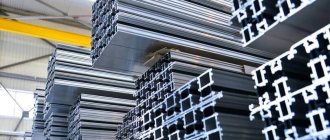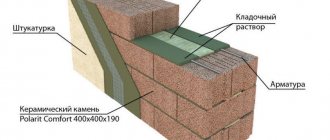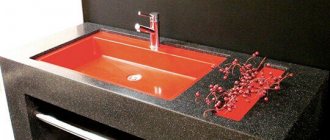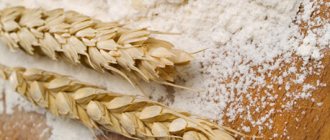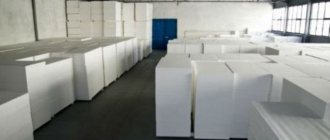Business relevance
The time when walls were decorated with clay is long gone. The modern construction market offers many finishing options. Some of them can be called flexible stone or flexible marble. This is a thin layer of sandstone (2-5 millimeters), which is held together with a textile-based polymer. For insulation and finishing of the facade, thermal panels are used, which consist of polyurethane foam and a facing part in the form of: clinker tiles, marble chips or sheets of flexible stone.
Due to their excellent characteristics, these materials are often used for finishing work. But since the technology for producing flexible stone and thermal panels is quite new, entrepreneurs are in no hurry to launch lines and workshops for the production of this material. But in vain - this direction can bring good profits. There is little competition, and the cost of the final product is quite high. This will make it possible to quickly recoup costs.
How much money do you need to start a business producing thermal panels?
One of the main features of a business is that you need to invest money in it. The production of thermal panels is not considered an exception among the huge number of business ideas. Fixed funds in this production are spent on renting or purchasing premises and equipment. In addition, you may want to save money, and instead of producing clinker tiles, the choice will fall on purchasing them from suppliers. In this case, the company will be able to save money at first, but in the future, if the business takes off, it will still have to buy the necessary equipment.
In order to establish stream production of thermal panels, in which 360 elements will be produced in one shift, you will have to spend some money on the purchase of equipment, renting premises and equipment for production needs, and in addition, on raw material reserves. The amount will be about 5 million rubles (if you count it together with the equipment for creating clinker tiles).
Organizing a production of this scale (360 panels per shift) will require an area of 250 m². Profitability on average per year is often 20%. The finances invested in the production of thermal panels according to this plan usually pay for themselves in 9-18 months. Personnel for such production will also be required. To produce 360 panels per shift, it is necessary to hire 14 people.
Production does not have to require such large expenses, but if you invest less, it will pay off much later. In the production of smaller-scale thermal panels, the efficiency of which will be measured by 100 panels per shift, costs will reach approximately 1.4 million rubles (excluding equipment for creating clinker tiles).
An industrial plant with an efficiency of approximately 90 panels per shift will require a floor area of at least 100 m². You will also need to hire a staff of 9-10 people. The average annual profitability of such production is 17-18%, and financial investments will pay off much later than the previous option - in a period of 12 to 24 months.
Is it profitable?
Trying to open your own business is always a risk, because you can incur losses. How big is this chance in a thermal panel production project? These structures, as previously written, are accelerating their pace in gaining first place among building materials. This circumstance increases the chances of success, but if something becomes popular and profitable, then this idea is picked up by many, creating competition in the niche. Therefore, you need to act ahead of your competitors.
In the best case, and with serious investment, the thermal panel production business will pay off in about 9 months. While not all places are occupied in the market and thermal panels have not become the most popular material, perhaps it is worth occupying this niche?
Basic properties
Thermal panels are slabs of polyurethane foam (which is sometimes replaced with polystyrene foam or mineral wool) with a decorative coating.
Flexible stone is sold in sheet form. In terms of its characteristics, it is similar to linoleum, but unlike it, it has a rough structure and is made from natural marble chips.
Flexible stone and thermal panels have many advantages:
- long service life, resistance to environmental influences;
- aesthetic appearance with sandstone texture;
- Ease of use;
- plastic;
- resistance to moisture;
- light weight, which simplifies work with the material and transportation;
- environmental friendliness - the material is made from natural ingredients and is safe for human health;
- fire safety
But the main feature is its wide scope of application. Thermal panels and flexible stone are used for finishing facades, swimming pools, fireplaces, floors, and stairs. This material is often used for landscape design and frescoing.
FTP Europe
The manufacturing company FTP-Europa, along with producing its own products, sells products from other factories. It positions itself as a manufacturer of high-quality panels, but models with clinker tiles are of German origin, and porcelain stoneware coatings are supplied from Europe. In fact, only the creation of an insulating layer on materials produced by third-party companies can be classified as domestic production.
The company's assortment includes panels with clinker tiles, with the use of porcelain tiles, plinth options and with an imitation of an aged surface. Expanded polystyrene and polyurethane foam are used as the inner layer.
| Model | Dimensions, mm | Insulation thickness, mm | Cost per sq. m, rub. |
| Odra | 1 000 × 650 × 60 | 40, 60, 80 | From 1 100 |
| Laura | 1 000 × 650 × 60 | 40, 60, 80 | From 2 540 |
| 351-kalkbranda | 760 × 660 | 40, 60, 80 | From 2 100 |
| mix2 | 760 × 660 | 40, 60, 80 | From 2 550 |
| 353-eisenrost | 760 × 660 | 40, 60, 80 | From 3 600 |
Stages of building a business
The idea of manufacturing thermal panels and flexible stone as a business can be a good start for aspiring entrepreneurs who want to work in the production sector, but do not have multi-million dollar investments. The business plan should consist of the following points:
- concept development, demand and competition analysis;
- familiarization with production technologies;
- registration of permits;
- preparation of the premises;
- purchase of equipment, inventory;
- establishing the production process;
- search for sales channels.
Flexible stone manufacturing technology
The production of natural flexible stone requires a lot of labor. Most often it is produced immediately at the site of sandstone extraction - in a quarry. Experts cut off a thin layer of sandstone and glue it onto a textile base. The resulting material is expensive. The price per square meter starts from 3,500 rubles. Not everyone can afford such finishing, and there are few places left with sand quarries in Russia.
That is why there are two ways to develop a business - buying natural sandstone cuts or producing flexible stone yourself. The latter option is more suitable for obtaining a cost-effective and high-quality finishing material. As a result, large investments will not be required to purchase equipment, and the price of the material will not be so high.
Technology for the production of flexible stone from artificial components:
- processing of marble chips and quartz sand with special pigments;
- preparation of textile base and adhesive;
- applying stone chips to the base;
- drying the material;
- cutting the material into sheets of specified parameters.
This technology is simple and does not require special skills or large labor costs. Production can be organized on an area of 30 m².
Thermal panels manufacturing technology
The production technology of thermal panels is simple. If clinker thermal panels are manufactured, then the algorithm of actions is as follows:
- anti-adhesive lubricant is applied to the mold (for ease of removal of the finished product);
- clinker tiles are laid in the cells of the mold;
- the edges of the matrix, which is located between the tiles, are sprinkled with sand;
- using pouring equipment, the mold is filled with polyurethane foam in liquid form;
- The form is closed until the components dry.
- At the end, the monolithic thermal panel is removed from the mold.
If the panels are made with marble chips, then the process is as follows:
- polystyrene foam PSB-35 is used for the base;
- a polymer adhesive layer is applied;
- natural marble chips are applied;
- A protective polyurethane coating is applied.
If flexible stone is used for cladding, then the process comes down to combining foam plastic with textile sheets of flexible marble (stone).
Thermal panels - what are they?
The production of thermal panels as a business requires the entrepreneur to study the very process of their production. And this is impossible without understanding what a heating panel is and what components it has. It includes:
- Metallic profile . This component ensures high strength of the finished product. It is with the help of the profile that the thermal panel is securely attached to the facade.
- Facing . Concrete is used for its production. This, in turn, is obtained by mixing cement and granite screenings. A little water is poured into them to eliminate the possibility of cracks appearing on the surface of the cladding. This allows you to obtain a thermal panel that can easily withstand changes in temperature and humidity. The surface of the product itself can be painted in the desired color - the paint will be distributed evenly over the surface, no streaks or stains will appear.
- Insulation . It is polystyrene foam 5–10 centimeters thick. Depending on the size of the insulation, the entrepreneur receives thermal panels with a different range of applications. Some of them are suitable for insulating ready-made houses, some can be used for building walls.
The parts are connected to each other using high-strength adhesives. This ensures excellent quality and strength of the panels.
Financial plan
Starting costs for organizing a mini-workshop will be:
- purchase of equipment – 800 thousand rubles;
- preparation of permitting documentation – 6 thousand rubles;
- preparation of the premises - 150 thousand rubles.
Total – 956 thousand rubles.
Product cost:
| Costs for production of 1 m² of flexible stone (rubles) | Costs for production of 1 m² of thermal panel (rubles) | |
| Raw material costs | 150 | 230 |
| Labor costs | 50 | 50 |
| Electricity | 5 | 5 |
| Additional expenses | 5 | 5 |
| Total | 210 | 290 |
The cost of flexible stone varies between 900-1300 rubles, thermal panels - from 1200 to 1800 rubles per square meter.
By producing and selling 50 m² of this product, you can earn 80 thousand rubles (690x50 +910x50). For the calculations, the minimum threshold and the most pessimistic sales forecasts were taken. Successful entrepreneurs in this field earn 500-700 thousand rubles per month.
Premises requirements
A number of requirements are put forward for the premises in which the production of façade thermal panels and flexible stone is planned:
- area – from 30 m²;
- temperature – from 15ºС to 25ºС;
- lighting level – general;
- Exhaust ventilation and sewage drainage are desirable.
The room must be divided into zones:
- room for preparing mortar for flexible stone;
- a place to install a machine for applying the solution;
- area for working with sand and marble chips;
- drying room;
- warehouse for storing finished products.
"Facade Materials Workshop" (MFM)
“Facade Materials Workshop” offers options with clinker tiles and artificial stone (the texture on the models is presented in the form of brick or stone). The thickness of the insulation is from 30 to 100 mm.
The company's assortment includes:
- “Classic” tiles, imitating the shape of brickwork;
- “German Collection” panels – a replica of clinker, popular in Germany;
- “Spanish Collection” panels – replicas of Spanish texture;
- “Stone Collection” tiles imitating natural stone masonry.
| Model | Dimensions, mm | Insulation material and thickness, mm | Cost per sq. m, rub. |
| One and a half brick | 1 250 × 600 × 60 | EPPS, 50 | From 1 590 |
| Beveled travertine | 1 250 × 600 × 70 | EPPS, 50 | From 1 950 |
| Gretta | 1 215 × 600 × 65 | EPPS, 50 | From 1 800 |
| Canyon | 1 200 × 600 × 110 | EPPS, 80 | From 2 750 |
| Terra brick | 1 040 × 600 × 65 | EPPS, 50 | From 1 690 |
Equipment
Equipment for the production of flexible stone for beginners is inexpensive. To start production at home, all you need is:
- mixer;
- drills;
- sifter for sand and marble chips;
- a special table on which the crumbs will be applied to the base;
- drying cabinet;
- racks for drying finished products.
Equipment for the production of thermal panels with your own hands:
- block forms;
- compressor;
- spray gun;
- vacuum installation.
Do-it-yourself installation of facade thermal panels
Many believe that if you have the necessary tool at hand and have the skills to work with it, then you can easily install facade thermal panels with your own hands. But every job has its own rules, ignorance of which can negate all efforts.
Thermal panels are considered a facing material. Before starting their installation, you should read the operating instructions.
Two styling options
Installation methods
Experts practice two methods of installing panels, it depends on the chosen material.
- Seamless. This is the most financially and labor-intensive method. By choosing this option, you can save on material.
- With seam filling. This method differs from the first option in that after laying the panels, the seams between them need to be filled with mortar to give the surface a finished look.
Assessment of upcoming work and surface to be laid
This procedure is simply necessary before starting installation. At its core, laying thermal panels is similar to tiling a surface. The difference here is that in the second case, by applying more glue to the ceramic, you can hide any unevenness. In the case of thermal panels, this option will not work. All you need is a flat surface.
What to do before installation
Preparatory work
- Level the surface (maximum deviation no more than 10 mm).
- Plaster all holes and potholes, and cut off and sand protruding areas.
- If there are deeper unevenness on the surface, they must be compensated for with gaskets made of any moisture-resistant material.
Selection of material
Thermal panels
In order to carry out all the work without a hitch, it is necessary, before starting finishing, to stock up on all the elements that will be needed for this.
- Thermal panels. Their number is calculated by multiplying the entire length by the height. After this, the area of window and door openings is subtracted from the resulting amount.
- Corner elements. The amount of this material is calculated by measuring the length of all external and internal corners of the facade.
Surface requirements
Regardless of the surface on which the façade thermal panels will be installed, the base must meet the following requirements:
- Firstly, it must be dry, no more than 5% humidity is allowed (here a depth of up to 3 cm is taken into account) for cement surfaces, and 1% for wooden and plaster surfaces.
- Secondly, strength. This property is taken into account for plastered and gypsum surfaces. There should be no cracks or peeling on them.
- Thirdly, clean. Immediately before installation (if the work is not carried out on the sheathing), you need to clean the base from all extraneous traces of dirt, paint, oil, etc.
Features of surface finishing
How to properly prepare the surface for laying thermal panels?
Wooden house
Finishing a wooden house
Wooden walls are prepared as follows:
- First, waterproofing or moisture-proof paper is attached. It is better to do this with horizontal stripes, starting from the top. So that each top sheet covers the bottom one by 5–7 cm.
- After this, the plaster mesh (anti-corrosion) is secured using special staples or galvanized nails. On the internal and external corners such a mesh should be laid in two layers.
- A layer of plaster is applied to the mesh to create a smooth surface for laying the panels. Recommended thickness 1–1.5 cm.
Concrete wall
In principle, there should not be any particular problems when covering such a surface. The only thing you need to check before work is porosity. At high density it will be minimal, and in this case it must be treated with a water repellent.
Brick
New masonry, if it is sufficiently smooth, without voids or gaps, is not subject to additional processing, and installation of thermal panels can be carried out directly on it. The old masonry is cleaned of efflorescence, treated with a water repellent and plastered.
Note! If you need to veneer an old building, and there is no point in plastering it, or this will require a lot of material, you can think about constructing a sheathing on which thermal panels can be mounted.
Let's get started - marking the bottom point
After the preparatory work, you need to mark the bottom line from which installation will begin. If there is a clearly defined boundary on a building between the facade and the basement, then it can be used as a “zero” line. In other cases, to mark the entire area, you need to draw a horizontal line, from which work will begin.
Note! If a building has differences in height, and, for example, a wall on one side is higher than on the other, then such a line for each wall should be marked from a new level.
A guide is mounted along the entire length of the “zero” mark, which will act as a low tide. When installing it, great attention should be paid to the horizontal installation, because the outcome of the work will depend on this. Use a level to check.
The preparatory work has been completed, let's move on to the main task.
How are thermal panels installed?
Necessary materials for work
- To understand a little what the principle of installation is, and to have a little idea about the choice of the next element, it is recommended to first lay out the panels on a horizontal surface.
- The result of the work will look more natural if during the installation process you alternate all the elements in size and color.
- If you purchased panels for seamless installation, then they need to be laid from bottom to top, pressing the top row as close as possible to the bottom.
Laying technology
Using a trowel, you need to apply a layer of mortar (about 1.5 cm) to the back of the panel and press the panel against the wall. Then move the panel a little before finally fixing it, the adhesive mixture should be squeezed out from under the panel.
After removing the excess mortar, do the same procedure with the following elements until you have laid the first row.
Note! When using panels for seamless installation, make sure that the end sides are filled with a small layer of glue.
When carrying out work in dry weather, immediately before laying the element, it must be moistened with a brush dipped in water. The same must be done with the installation site.
How do you unstitch seams?
This is an important point in the work; the integrity of the coating depends on its correct implementation. It is performed by filling the joints with cement mortar. High-quality jointing will not allow moisture to penetrate under the panels, otherwise this may result in destruction due to frost.
For jointing, you can use a thick plastic bag with a corner cut off, only its size should be slightly smaller than the seam between the panels.
Joining instructions
- Fill the bag completely with the solution, and, carefully squeezing it out, fill all the seams with it. Make sure that the solution does not remain on the panels.
- After setting, the seams must be compacted. This is done with a small wooden spatula. There is no need to try to compact it immediately after jointing; the liquid solution will only stain the thermal panels, and you will have to clean them later.
- To finally level the seams after compacting them, you need to cover them with a broom made of plant material or plastic.
- The final stage will be to treat the surface with a water-repellent composition, but this can only be done after the adhesive has completely dried.
Correct installation of façade thermal panels will create a perfect resemblance to brickwork or other type of finishing material and will give the building an individual look.
Video
This video shows the process of laying thermal panels:
And this video is about filling seams:
Last edition: 04/13/2015 Author: Andrey Makarov
fasadoma.ru

